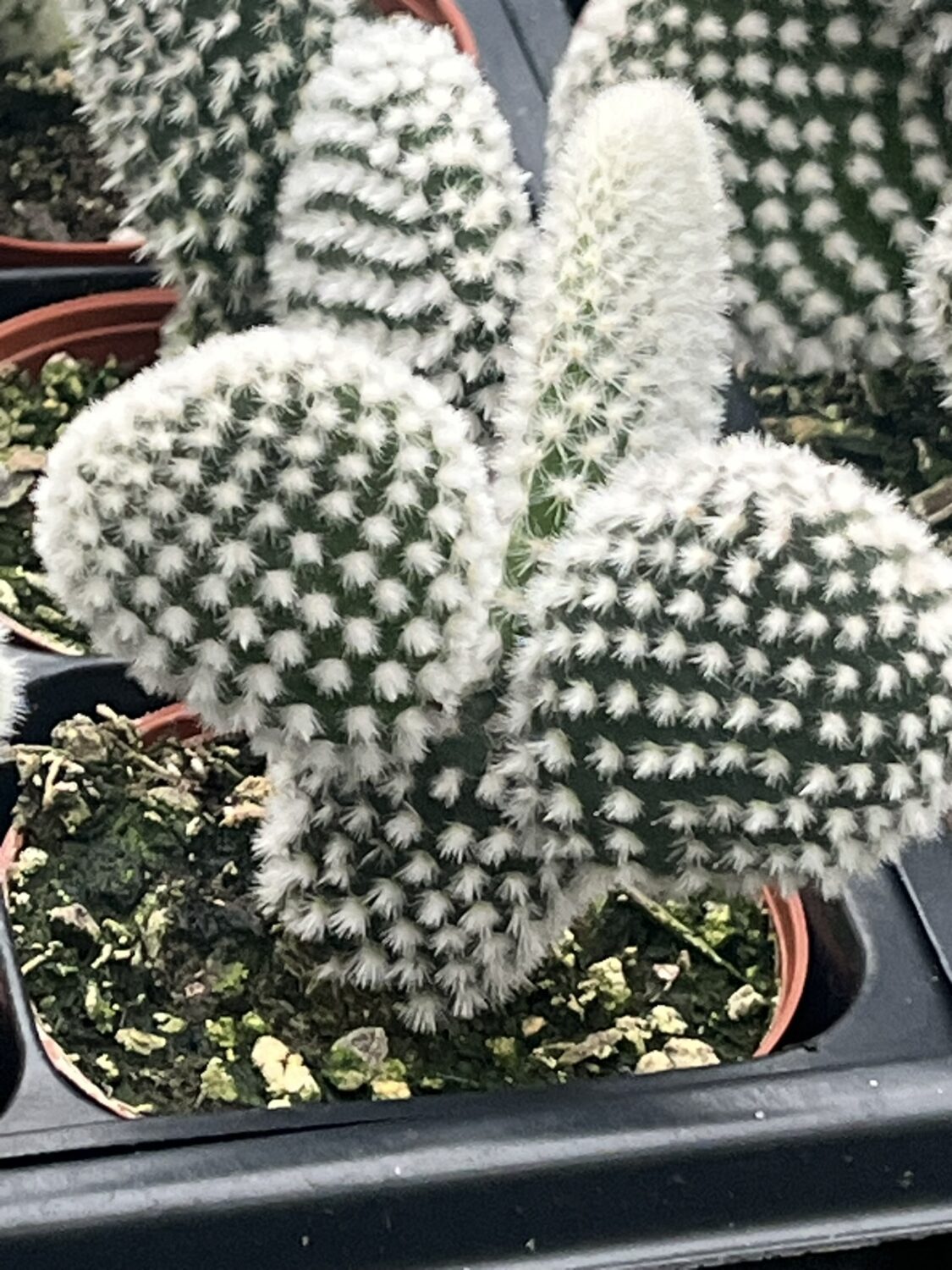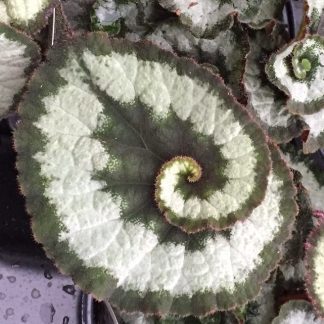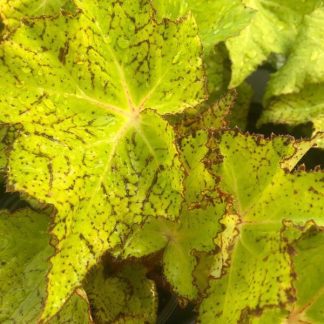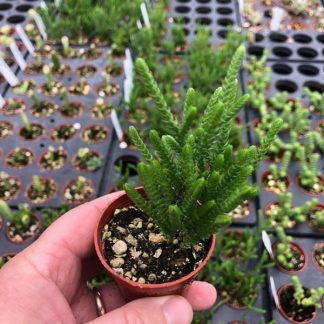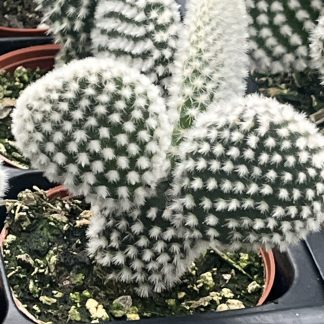Description
Opuntia microdasys ‘Bunny Ears’: The Delightful Desert Beauty
Opuntia microdasys, better known as the Bunny Ears Cactus, is a small wonder of the desert. With its round, ear-like pads and soft golden tufts, this cactus has charmed plant lovers for generations. Native to the dry lands of northern Mexico, it thrives in heat, shrugs off drought, and brings a playful shape to gardens and homes alike.
This cactus isn’t just cute. It’s resilient, easy to grow, and full of character. Whether you keep it indoors by a sunny window or add it to a rock garden outside, the Bunny Ears Cactus offers both beauty and simplicity.
What Makes the Bunny Ears Cactus Stand Out?
The Bunny Ears Cactus belongs to the Opuntia family, known for its jointed pads. Unlike many of its relatives, it has no long, dangerous spines. Instead, its pads are dotted with tiny clusters of glochids—barbed hairs that look soft but can stick to your skin. Handle them with gloves or tongs for safety.
-
Adorable Shape: Rounded pads grow in pairs, mimicking rabbit ears.
-
Compact Size: Mature plants reach about 2 to 3 feet tall, making them perfect for small spaces.
-
Seasonal Flowers: In summer, bright yellow blooms may appear, followed by small, red edible fruits in ideal conditions.
-
Color Variety: Glochids can be golden or white, adding even more charm.
Why Add Bunny Ears to Your Collection?
There’s a reason this cactus shows up in so many plant collections:
-
Visual Appeal: Playful, sculptural, and instantly recognizable.
-
Low Maintenance: Thrives with very little water or fuss.
-
Air Purifying: Like other succulents, it helps clean indoor air.
-
Space-Friendly: Works well in pots, windowsills, or tiny gardens.
Growing Opuntia microdasys: A Complete Care Guide
Caring for the Bunny Ears Cactus is simple if you mimic its desert home—plenty of sun, minimal water, and sandy soil.
1. Light Needs
-
Indoors: Place it in a south- or west-facing window with at least six hours of bright, direct sunlight daily.
-
Outdoors: Full sun is best. Acclimate gradually to prevent sunburn.
-
Low Light Warning: Weak or stretched pads signal not enough light.
2. Temperature and Humidity
-
Ideal Range: 70°F to 100°F (21°C to 38°C) during active growth.
-
Winter Tolerance: Can handle down to 50°F (10°C), but protect from frost.
-
Humidity: Loves dry air; avoid humid spots like bathrooms.
3. Soil
-
Best Mix: Cactus potting soil or a blend of regular soil with sand, perlite, or pumice.
-
pH Preference: Slightly acidic to neutral (6.0–7.0).
-
Drainage: Essential to prevent root rot.
4. Watering
-
Spring & Summer: Water deeply but rarely. Let soil dry completely between waterings.
-
Fall & Winter: Water once a month or less; the cactus rests during cooler months.
-
Overwatering Signs: Yellow, mushy pads or rotting roots. Always ensure drainage holes.
5. Fertilizing
-
Active Season: Feed monthly with diluted cactus fertilizer or a low-nitrogen blend.
-
Dormant Season: Skip feeding during fall and winter.
6. Potting and Repotting
-
Pot Choice: Terracotta or ceramic pots with drainage holes work best.
-
When to Repot: Every 2–3 years or when roots crowd the pot.
-
Repotting Tips: Wear gloves, remove the cactus gently, refresh soil, and avoid overwatering right after repotting.
7. Propagation
Propagation is one of the easiest and most fun parts of owning Bunny Ears.
Steps for Pad Cuttings:
-
Use sterilized scissors or a knife to cut a healthy pad.
-
Let it dry for 1–2 days so a callus forms over the cut.
-
Place the pad upright in sandy soil, burying just the base.
-
Keep in bright, indirect light and water sparingly until roots grow.
Caring for Bunny Ears Year-Round
Once established, the Bunny Ears Cactus needs only basic upkeep.
Pest and Disease Control
-
Common Pests: Mealybugs and spider mites are the main culprits. Treat with neem oil or insecticidal soap.
-
Fungal Problems: Usually from overwatering—improve drainage and airflow to prevent rot.
Pruning
-
Remove damaged or diseased pads using gloves and sterilized tools. This keeps the plant tidy and healthy.
Seasonal Adjustments
-
Winter: Bring potted plants indoors if temperatures drop below 50°F or cover outdoor ones with frost cloth.
-
Summer: Provide light shade during extreme heat to prevent sunburn.
Styling and Decorating Ideas
The Bunny Ears Cactus is versatile and looks stunning in many settings:
-
Indoor Spaces: Use decorative pots to highlight its whimsical shape. Perfect for windowsills, desks, or sunny shelves.
-
Outdoor Gardens: Combine with other succulents in rock gardens or xeriscapes for a natural desert vibe.
-
Miniature Displays: Pair with small succulents in a shallow dish or terrarium for a playful desert scene.
A Touch of Desert Magic
The Bunny Ears Cactus is more than just a houseplant—it’s a little piece of desert art. Its rounded pads and golden tufts brighten any corner, while its low-maintenance nature makes it perfect for beginners and collectors alike.
When you bring one home, you’re not just adding greenery. You’re adding movement, texture, and charm. With proper sunlight, careful watering, and the right soil, this cactus can thrive for years, becoming more delightful as it grows.
Ready to add a dash of desert whimsy to your space? The Bunny Ears Cactus is waiting to hop into your collection.

